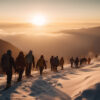Best Time to Trek Kuari Pass: A Season-Wise Guide
Kuari Pass, nestled in the Garhwal region of Uttarakhand, is one of the most stunning trekking destinations in India. Known for its breathtaking views of the Himalayan peaks like Nanda Devi, Dronagiri, and Kamet, the trek offers a mesmerizing experience for adventure enthusiasts. However, choosing the right time for the trek is crucial to make the most of this thrilling journey. In this guide, we will explore the best seasons for Kuari Pass Trek and how they impact your trekking experience. If you’re planning your adventure, consider opting for a Kuari Pass Trekking Package for a well-organized and hassle-free trip.
Spring (March to April) – A Blooming Paradise
Spring is one of the most beautiful times to embark on the Kuari Pass Trek. During this season, the trails come alive with vibrant rhododendrons, lush greenery, and moderate temperatures, making it an ideal time for trekking.
Why Choose Spring?
- Pleasant Weather: The temperature ranges from 5°C to 15°C, providing comfortable trekking conditions.
- Blossoming Flora: The trails are adorned with colorful rhododendron flowers and green meadows.
- Clear Views: The Himalayan peaks remain visible, offering breathtaking panoramas.
A Kuari Pass Trekking Package during spring ensures you enjoy nature at its best, with well-planned itineraries covering scenic campsites and top attractions.
Summer (May to June) – Ideal for Beginners
Summer is another excellent season for Kuari Pass trekking, especially for beginners. The trails are dry, and the days are warm, making it easier to navigate the terrain.
Why Choose Summer?
- Mild Weather: The temperature ranges between 10°C to 20°C, making the trek comfortable.
- Snow-Free Paths: By mid-May, most of the snow melts, making the trails easier to walk on.
- Best for Beginners: The absence of extreme cold and heavy snow makes it an ideal time for first-time trekkers.
Booking a Kuari Pass Trekking Package in summer ensures that you experience the trek with professional guides and well-equipped campsites, making your journey smooth and enjoyable.
Monsoon (July to September) – Not Recommended
Monsoon is generally not an ideal time for Kuari Pass trekking due to heavy rainfall, slippery trails, and the risk of landslides.
Why Avoid Monsoon?
- Heavy Rains: Persistent rainfall makes trekking difficult and risky.
- Leech Infestation: The trails become home to leeches, making the trek uncomfortable.
- Obstructed Views: Clouds and mist cover the stunning Himalayan landscapes.
While trekking is not advisable in this season, some adventure seekers still opt for it. However, finding a reliable Kuari Pass Trekking Package may be difficult as many operators suspend their services during monsoon.
Autumn (September to November) – The Best Season
Autumn is considered the best time to trek Kuari Pass. With clear skies, pleasant weather, and post-monsoon freshness, this season offers the most rewarding experience.
Why Choose Autumn?
- Crisp and Clear Views: The monsoon rains wash away dust and pollution, offering crystal-clear views of the Himalayan range.
- Moderate Weather: Temperatures range from 5°C to 15°C, making trekking conditions ideal.
- Less Crowded: Compared to spring and summer, autumn sees fewer trekkers, allowing for a more peaceful experience.
A Kuari Pass Trekking Package during autumn ensures a well-structured trek with professional guidance, helping you make the most of this spectacular season.
Winter (December to February) – A Snowy Wonderland
For those who love snow trekking, winter is the perfect time to visit Kuari Pass. The entire region transforms into a white paradise, offering a surreal experience.
Why Choose Winter?
- Snow-Covered Landscapes: The trail is blanketed with snow, creating a magical trekking experience.
- Adventure Challenge: This season is ideal for experienced trekkers who enjoy snow trekking.
- Frozen Campsites: The experience of camping in the snow is thrilling for adventure lovers.
A Kuari Pass Trekking Package in winter is perfect for those seeking a challenging and picturesque trek. However, it is recommended only for seasoned trekkers due to extreme cold and difficult trail conditions.
Conclusion
The best time to trek Kuari Pass depends on your preferences and experience level. For beginners, summer and autumn are ideal, while adventure enthusiasts can opt for winter. Spring offers stunning floral landscapes, whereas monsoon should be avoided due to heavy rains. To make your trek hassle-free, consider booking a Kuari Pass Trekking Package, which ensures a well-organized and enjoyable adventure.
No matter when you choose to trek, Kuari Pass promises an unforgettable experience, filled with nature’s beauty, thrilling trails, and breathtaking mountain views.



